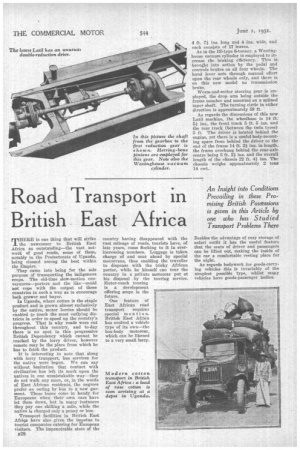Road Transport in British East Africa
Page 46

If you've noticed an error in this article please click here to report it so we can fix it.
An Insight into Conditions Prevailing in these Promising British Poseessions is given in this Ankle by one who has Studied Transport Problems There
MEM:LE is one thing that will strike
the newcomer to British East Africa as outstanding—the vast network of good roads, some of them, notably in the Protectorate of -Uganda, being classed among the best within the Empire.
They came into being for the sole purpose of transporting the indigenous crops. The old-time slow-motion conveyances—porters and the like—could not cope with the output of these countries in such a way as to encourage both grower and buyer.
In Uganda, where cotton is the staple product and is grown almost exclusively by the native, motor lorries should be enabled to touch the most outlying districts in order to speed up the country's progress. That is why roads were cut throughout this country, and to-day there is no snot in this progressive British Dependency which cannot be reached by the lorry driver, however remote may be the place from which he has to fetch the product.
it is interesting to note that along with lorry transport, bus services for the native were begun. We can say without hesitation that contact with civilization has left its mark upon the natives in one unmistakable way—they do not walk any more, or,. in the words of East African residents, the negroes prefer an outing by bus to a new garment. These buses come in handy for Europeans when their own cars have let them down, but in many instances they pay one shilling a mile, while the native is charged only a penny or less.
Transport facilities in British East Afriga. have also given the impetus to tourist companies catering for European visitors. The impenetrable state of the B28 country having disappeared with the vast mileage of roads, tourists have, of late years, come flocking to it in everincreasing numbers. Luggage is taken charge of and sent ahead by special motorvans, thus enabling the traveller to dispense with the tricky African porter, while he himself can tour the country in a private motorcar put at his disposal by the touring service. Motor-coach touring is a development offering scope in the future.
One feature of East African road transport requires special mention. British East Africa has evolved a vehicle type of its own—the box-body motorcar, which can be likened to a very small lorry.
Besides the advantage of easy storage of. safari outfit it has the useful feature that the seats of driver and passengers can be lifted out, making the inside of the car a comfortable resting place for the night.
As regards bodywork for goods-carrying vehicles this is invariably of the simplest possible type, whilst many vehicles have goods-passenger bodies.




































































































